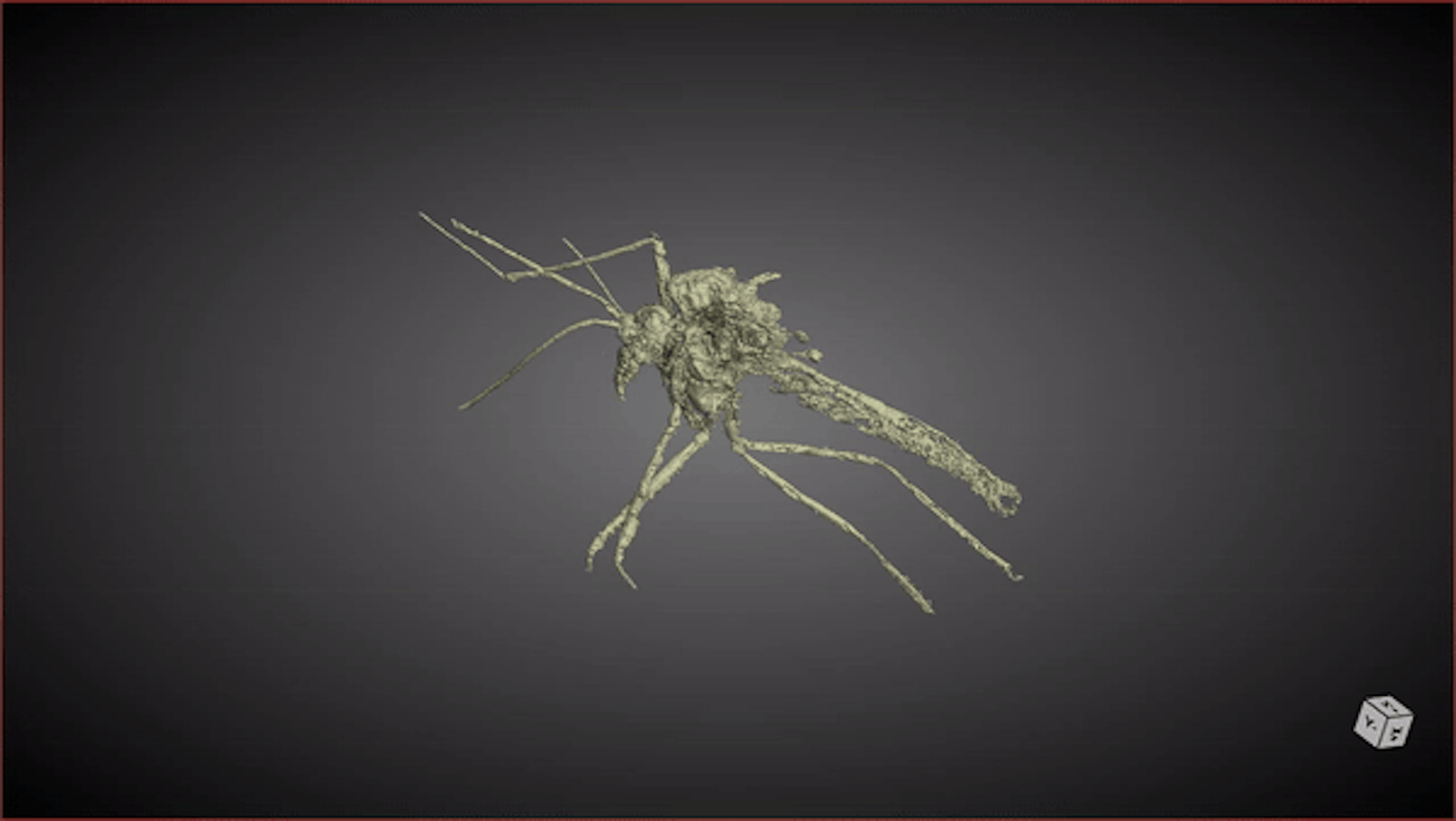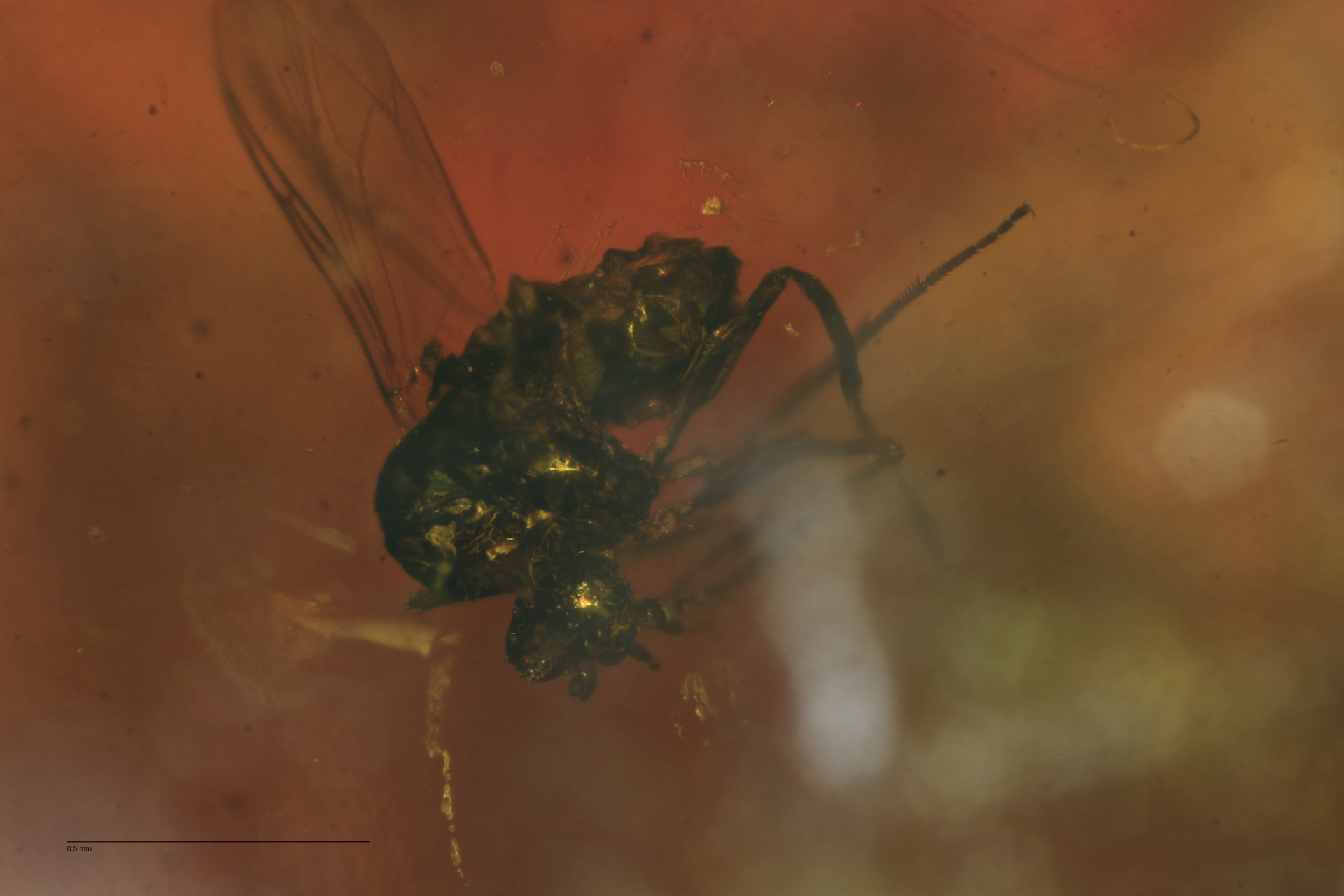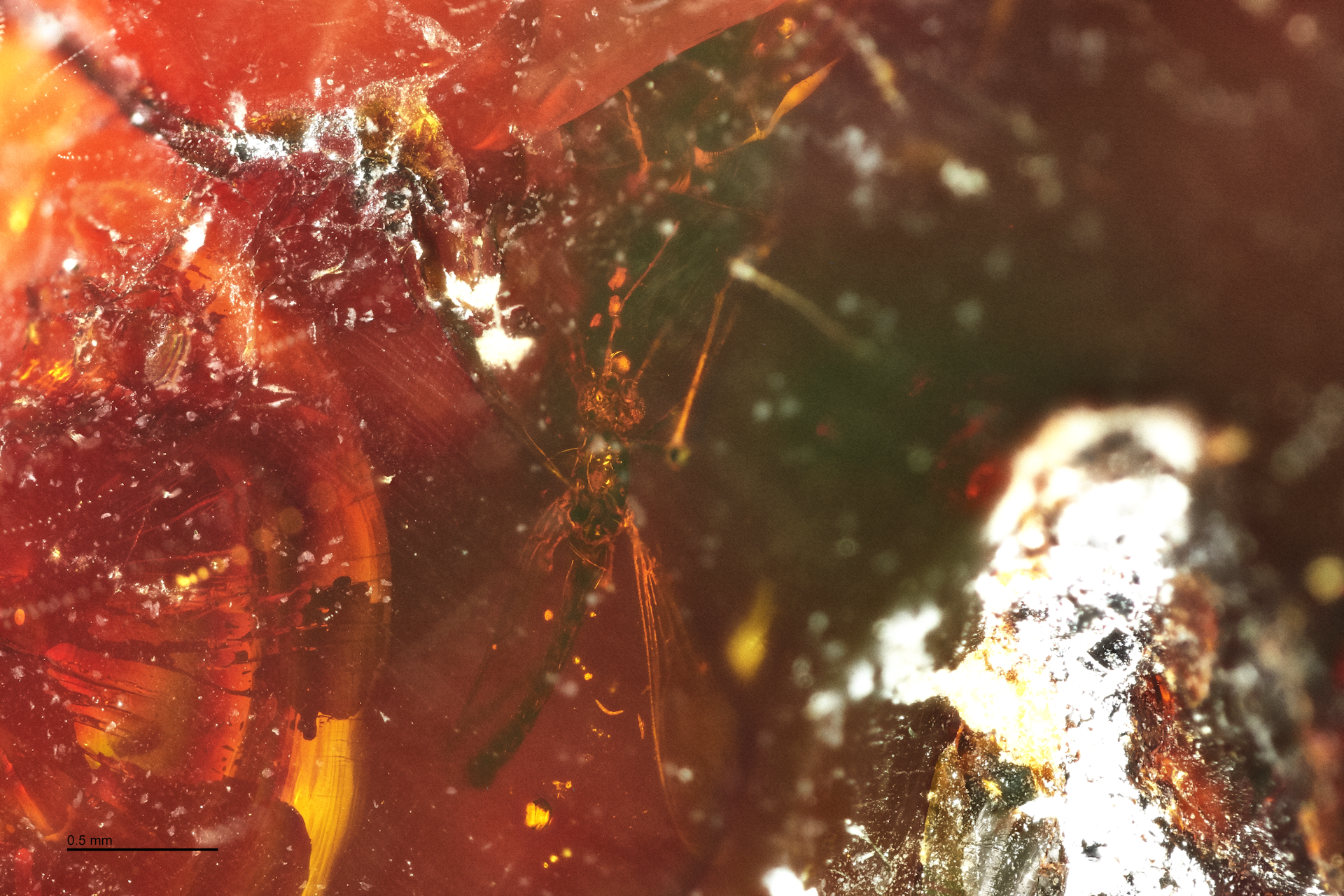Australian amber has revealed ‘living fossils’ traced back to Gondwana 42 million years ago
Amber is especially good for preserving in exquisite details, small arthropods which don't fossilise well in rocks, like larger vertebrates with hard body parts, and we can be confident that the age of the fossil is the age of the amber in which it is preserved.
Some years ago, on holiday in Kassandria, Greece, I came across a small group of Mediterranean pines that were being use to collect the resin used to flavour the local wine, Retsina. This wine is something of an acquired taste but is best drunk chilled, with Greek food, on a warm summer evening at sunset, overlooking the Aegean - and probably after a bottle or two of Demestica.
The fascinating thing was how many ants had managed to get themselves trapped in the resin in the plastic containers it was draining into from the cuts in the tree bark.
There were so many that I can only assume that when ancient amber was being produced there were either fewer ants or less resin.
So, what can we tell from the fossils preserved in amber?
Partly from their occurrence in amber, we know that some 85% of all living species were arthropods, rather than the 0.3% of species that were the much more noticeable vertebrates. We can also tell where and when major orders evolved and how long some of them have existed for. Since amber is formed from tree resin, it follows that it only occurred after trees evolved and from the resin produced by specific species of tree in areas where these trees grew.
How is amber formed and how is it dated? Amber is a fossilized tree resin that has been appreciated for its color and natural beauty since Neolithic times. Here's a detailed look at how amber is formed and how it is dated:Here then is what Maria Blake, a PhD student and Associate Professor Jeffrey Stilwell, School of Earth, Atmosphere and Environment, Monash University, Australia say Australian Amber has revealed in an article in The Conversation. Their article is reprinted here under a Creative Commons license, reformatted for stylistic consistency:
Formation of Amber
Dating Amber
- Resin Production: Amber starts as resin, a sticky substance secreted by certain trees, primarily from the family of conifers. This resin may ooze out due to tree wounds, insect attacks, or other stress factors.
- Deposition and Burial: The resin often traps small organisms such as insects, spiders, and plant material, which become embedded within it. Over time, the resin hardens and gets buried under layers of sediment.
- Fossilization Process: Over millions of years, the resin undergoes a series of chemical changes, including polymerization (the linking of smaller molecules into larger ones) and isomerization, where the molecular structure changes. This process turns the resin into copal, a semi-fossilized resin. With further aging and geological processes, copal becomes fully fossilized and is known as amber.
- Geological Pressure and Heat: The transformation from resin to amber requires specific conditions of pressure and heat, typically provided by burial under sediments that increase the pressure and temperature over millions of years.
Dating amber involves determining its age, which can be done using several methods:Summary
- Stratigraphy: This method involves dating the layers of rock in which amber is found. By understanding the geological context and the age of the surrounding sediments, the age of the amber can be inferred.
- Paleontological Dating: Fossils trapped within the amber, such as insects or plant materials, can be studied. If these trapped organisms are known to have existed during a specific geological period, they can help date the amber.
- Radiometric Dating: This technique measures the decay of radioactive isotopes within the minerals associated with the amber. For example, carbon dating can be used for younger amber (up to about 50,000 years old), while other methods like uranium-lead dating can be used for older samples.
- Chemical Analysis: By analyzing the chemical composition and degree of polymerization, scientists can estimate the age of the amber. This is because the chemical changes that resin undergoes to become amber happen over known timescales.
- Infrared Spectroscopy: This technique analyzes the infrared light absorbed by the amber, providing information about its molecular structure. The degree of polymerization and other chemical changes can be indicators of age.
Amber is formed from tree resin that undergoes chemical and physical changes over millions of years under specific conditions of pressure and heat. Dating amber can be achieved through various methods, including stratigraphy, paleontological dating, radiometric dating, chemical analysis, and infrared spectroscopy. Each method provides insights into the age and formation process of this fascinating material.
How old is the oldest amber?
The oldest known amber dates back to the Carboniferous period, approximately 320 million years ago. This amber was discovered in the region now known as Illinois, USA. The discovery of such ancient amber helps scientists understand the early evolution of trees and resin production, as well as the types of ecosystems that existed during that time.
Details About the Oldest Amber
The discovery of such ancient amber is rare, as the conditions required for resin to fossilize into amber are specific and not commonly met over such vast geological timescales. However, these ancient finds are crucial for understanding the history of plant evolution and the development of resin production mechanisms in ancient forests.
- Period: Carboniferous (approximately 320 million years ago)
- Location: Illinois, USA
- Significance: The presence of amber from this period indicates that resin production by trees was already occurring in the Carboniferous period. This resin production is believed to have played a role in protecting trees from herbivorous insects and pathogens.
Which trees produced amber resin?
Amber resin is produced by various types of trees, primarily conifers, but also some angiosperms (flowering plants). Here's a detailed look at the types of trees that produced amber resin:
Coniferous Trees
Angiosperm (Flowering) Trees
- Araucariaceae: Trees from this family, such as the modern-day Araucaria (e.g., Norfolk Island pine), are well-known producers of resin that can fossilize into amber.
- Pinaceae: This family includes many well-known trees such as pines, spruces, and firs. Some species in this family are also significant sources of amber.
- Cupressaceae: Cypress trees, junipers, and redwoods belong to this family, which also includes trees that produce amber resin.
- Sciadopityaceae: This family includes the Japanese umbrella pine, which is known for producing resin that can become amber.
Notable Amber-Producing Trees in History
- Fabaceae: Some members of the legume family have been found to produce resin that fossilizes into amber.
- Dipterocarpaceae: This family includes tropical hardwood trees, primarily found in Southeast Asia, that produce copal (a precursor to amber).
- Burseraceae: Trees in this family, such as those producing the aromatic resin frankincense, also contribute to the formation of amber in some regions.
- Hymenaea: A genus within the Fabaceae family, particularly Hymenaea protera, is known to have produced significant amounts of amber in the Tertiary period. This genus is especially associated with amber found in the Dominican Republic and Mexico.
- Pseudolarix: This genus within the Pinaceae family, known as golden larch, has been linked to amber found in Asia.
Summary
Amber is primarily produced by coniferous trees, including members of the Araucariaceae, Pinaceae, Cupressaceae, and Sciadopityaceae families. Some angiosperms, particularly within the Fabaceae and Dipterocarpaceae families, also produce resin that can fossilize into amber. Notable historical producers of amber resin include trees from the genera Hymenaea and Pseudolarix.

Australian amber has revealed ‘living fossils’ traced back to Gondwana 42 million years ago
42-million-year-old biting midge.
Maria Blake, Monash University and Jeffrey Stilwell, Monash UniversityMaria Blake
Amber is fossilised tree resin. Unlike traditional fossils found on land or in the sea, amber can preserve ancient life forms in incredible detail. It’s often considered the “holy grail” of palaeontology worldwide.
Amber acts like a time capsule, capturing tiny animals, plants and even microorganisms from millions of years ago. These fossils – also known as inclusions – can appear astonishingly fresh, preserved just as they were when they died trapped in sticky tree resin.
Australian amber is now helping to understand the biological diversity of ancient Gondwanan environments from 42 million years ago and their connections to today’s Australian forests. From it, we can learn yet more reasons for why we must protect today’s forests.
The unique value of Australian amber
Unlike typical, squashed fossil rock shapes, palaeontologists value amber for its remarkable ability to preserve inclusions in full three dimensions. This means we can study fossil organisms that would otherwise not have been recorded in such detail.
This is especially important considering that around 85% of modern biodiversity comes from arthropods (spiders, flies, beetles, bees and the like). Only 0.3% is represented by the “bony” mammals more commonly found as fossils in rocks.
Overall, only a tiny fraction of all life throughout geologic time has been fossilised. This means we work with a biased fossil record that may not accurately represent past diversity.
Amber provides a unique opportunity to find less common specimens. It helps to reveal the diversity of past ecosystems and to reduce these biases in our understanding of ancient life.
Most amber discoveries come from the Northern Hemisphere (the Baltic region, Spain, China, Myanmar). Australia is one of the rare places in the Southern Hemisphere where scientists can also study organisms trapped in amber.
The most promising site for finding these preserved organisms is a former coal mining area in Victoria. The amber and fossils from this site are estimated to be 42–40 million years old, dating back to the Eocene epoch.
At that time, Australia and Antarctica were still connected as part of the slowly fragmenting supercontinent called Gondwana. Australia had a warm and moist climate, and forests teeming with insects, arachnids and other creatures.
Living fossils
The amber we’re working with has been studied by researchers since 2014. Findings described in 2020 include biting midges, baby spiders, and even a pair of mating flies.
Our latest work reveals more details on the species. We’ve learnt not only where these organisms lived in the past, but also the surprising fact that many of them still exist in Australia’s forests today, albeit in greatly reduced geographic ranges.
This means creatures from ancient Gondwana have persisted for more than 40 million years. Their survival for so long gives even more reason to protect them into the future.
One major breakthrough in our research is based on new advancements at ANSTO’s Australian Synchrotron research facility in Melbourne. Improved resolution and the capability to scan smaller samples with X-rays have greatly improved how we can produce images of organisms trapped in amber. This allows us to create detailed 3D reconstructions, and we can identify the species more easily.
The synchrotron has also made it possible to finally detect inclusions within large, opaque pieces of amber that were hard to examine previously with traditional microscopes.

3D reconstruction of a fossilised ‘non-biting’ midge based on X-ray scans from the Australian Synchrotron.
Some of the new major findings have been a “non-biting” or “feather” midge from the Podonominae insect subfamily. It’s the first fossil record of the genus Austrochlus in the Southern Hemisphere. Even though it was widely distributed globally in the past, it is now restricted to Australia.
With the synchrotron, we revealed not only the specimen’s sex and position in its family tree, but also internal structures of what are potentially wing muscles. Even in amber fossils, that’s a rarity.
We also found a true biting midge that’s still around today (Austroconops). It’s the first fossil of its kind dating back to the Cenozoic, spanning the last 66 million years. Once widespread, today this midge is only found in Western Australia, again restricted just to our continent.
A wasp from the family Embolemidae, recognised today from all around the world to be a parasite on planthopper nymphs, is another highlight from Australian amber. This group has quite a scarce fossil record, and this is only the second time one has been found in the Southern Hemisphere.
All of these insect fossils are the first of their kind found in Australia. And we’ve only scratched the surface – there are many more yet to be described.
Remarkably, these insects are still around in Australian forests today, tracing their lineage back in time to ancient Gondwana. Without realising it, we exist among living fossils.
While we know these species were widely distributed in the past, today most of them are found only on this continent. They now face new challenges which threaten their habitats. The threats include climate change, deforestation and urban sprawl.
Protecting these ancient “living fossils” and their environments is essential for the health of our native ecosystems.
Maria Blake, PhD student, Monash University and Jeffrey Stilwell, Associate Professor of Palaeontology, School of Earth, Atmosphere and Environment, Monash University
This article is republished from The Conversation under a Creative Commons license. Read the original article.
The surprising thing is that more of these fossils which, in some cases, are examples of extant species that have remained unchanged for some 42 million years, are not waved around by creationist frauds as 'proof' that there has been no evolution, but perhaps even they are embarrassed by the creationists who believe in a 10,000 year-old Earth, seeing nothing ironic in claiming a 66 million year-old unchanged [sic] coelacanth or horseshoe crab is proof that evolution doesn't happen, so Earth is just 10,000 years old. Joining the dots was never a creationist's strong-point.
There is nothing in the TOE that says all species need to evolve phenotypically over a few tens of millions of years, and, as the amber record shows, there are some which haven't, although, of course, we can't see their DNA to detect any genetic changes there might have been even if there was no significant change in phenotype. With so much 'junk' DNA in most species, it would be astonishing if these 'unchanged' species hadn't accumulated masses of neutral mutations in this 'junk' by genetic drift.
What Makes You So Special? From The Big Bang To You
How did you come to be here, now? This books takes you from the Big Bang to the evolution of modern humans and the history of human cultures, showing that science is an adventure of discovery and a source of limitless wonder, giving us richer and more rewarding appreciation of the phenomenal privilege of merely being alive and able to begin to understand it all.
Available in Hardcover, Paperback or ebook for Kindle
Ten Reasons To Lose Faith: And Why You Are Better Off Without It
This book explains why faith is a fallacy and serves no useful purpose other than providing an excuse for pretending to know things that are unknown. It also explains how losing faith liberates former sufferers from fear, delusion and the control of others, freeing them to see the world in a different light, to recognise the injustices that religions cause and to accept people for who they are, not which group they happened to be born in. A society based on atheist, Humanist principles would be a less divided, more inclusive, more peaceful society and one more appreciative of the one opportunity that life gives us to enjoy and wonder at the world we live in.
Available in Hardcover, Paperback or ebook for Kindle










No comments :
Post a Comment
Obscene, threatening or obnoxious messages, preaching, abuse and spam will be removed, as will anything by known Internet trolls and stalkers, by known sock-puppet accounts and anything not connected with the post,
A claim made without evidence can be dismissed without evidence. Remember: your opinion is not an established fact unless corroborated.